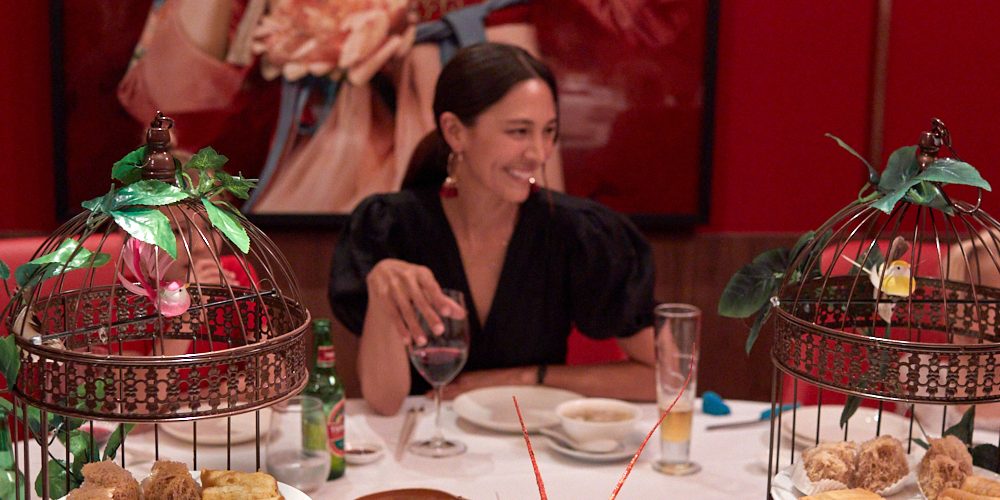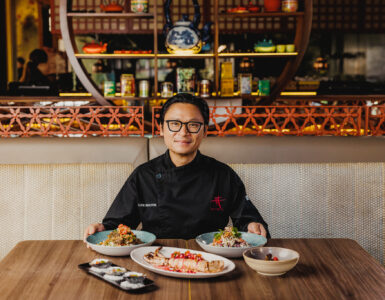From a Hong Kong island village to Sydney’s concrete jungle, Cara McIlroy recalls Lunar New Year memories from places she once called home.
Although mainly celebrated in Eastern and Southeast Asia, Lunar New Year has become an entrenched part of Australian culture. From eating to dancing, fireworks to family, it celebrates some of our favourite pastimes. As we get ready to celebrate, we wanted to learn more about this ancient, yet electric, event. We were lucky enough to have model, television host, entrepreneur, mother of three, and face of The Star’s Lunar New Year campaign, Cara (Grogan) McIlroy, share her Lunar New Year memories from her time living in Hong Kong.

Lunar New Year, also known as Chinese New Year or the Spring Festival, begins with the first new moon of the lunar calendar and ends on the first full moon, 15 days later. It’s a time when friends and family gather to feast and honour their ancestors and deities.
In every culture and society, we’re all familiar with myths, legends, and fairy tales – and Chinese New Year is no exception. Wearing red clothing, Spring cleaning or gifting red pockets to loved ones – these customs originate from legends and mythological folklore that are thousands of years old. “Chinese New Year is heavily steeped in tradition, and it was such a privilege to be amongst that energy during my many years in Hong Kong”, said Cara. “Hong Kong is a city that never sleeps. Chinese New Year is the only exception. For that period of time, the city is peaceful and slow – kind of magical. You feel a real energy shift. It’s hard to believe unless you have experienced it, but it’s the one time a year the city feels calm. It was always my favourite time of year.”

It’s said the origins of Lunar New Year began with a frightening sea beast named Nian, who is said to have found us humans rather tasty. But, a courageous beggar discovered Nian’s kryptonite; the colour red, bright flames and loud, cracking noises. His profound discovery chased Nian away and saved the village from Nian’s wrath and hunger. So, to pay homage to the beggar’s bravery and to ensure Nian remains in the depths of the ocean, families will wear new red clothing, eat meals surrounded by red decorations and release fireworks to commemorate and celebrate.

“Our village was alive in full force with people in new red clothes, sounds of firecrackers, families gathering together and children laughing and playing,” Cara explained.“The children loved visiting the elders to gather their Lai See red pockets with their “lucky money” inside. Dragon dances filled the paths that joined our homes. The dragon is a divine creature in Chinese tradition that represents auspiciousness, so it was always a part of the celebrations. We would even leave out lettuce for the dragon to feast on.”
Chinese New Year also allows for families and communities to celebrate their own unique traditions – special to only them. Cara told us about her fond memories foraging, picking and making jams from the sweet mandarins, kumquats and wampee grown in her village.
“This became our tradition, but the giving of these fruits is also meant to bring good luck and fortune”, she told us (whilst admitting to still having wampee cravings today). The end of the Chinese New Year is reflected with the Yuan Xiao or Lantern Festival.
“It was always so dreamy”, Cara recalls fondly. “The village was filled with gorgeous shades of flickering red light from lanterns of every size and shape. We would gather with all our friends and watch the children play with their lanterns. I will treasure the memories of my Chinese New Year celebrations forever”. This tradition dates back to the Western Han dynasty, and celebrates family, socialising, ancient spiritual traditions and is called by some, the true Chinese Valentine’s Day.

2022 marks the year of the Water Tiger. The Chinese Zodiac dates back to the Qin Dynasty over two-thousand years ago and is rooted in a system of zoolatry (or animal worship). As the legend goes, the Jade Emperor challenged all the animals in the Kingdom to a “Great Race.” Whoever arrived at his palace first would win his favor. The Tiger was sure he had the race in the bag, but due to the ever-cunning Rat working closely with the Ox, the Tiger ended up placing third. That’s why Tigers are known for their competitive, courageous and ambitious nature. We mustn’t forget, they’re also extremely generous with a drive to help others.
Water years tend to bring our emotions to the forefront, more so than any of the other elements of wood, fire, earth and metal. It’s why Water Tigers are all about family and their friendships and relationships. Despite their brash and competitive nature, they always aim to do what’s best for their loved ones.
For all of us, the Year of the Tiger is about making big changes. A year of risk-taking, adventure and finding enthusiasm for life. Generosity and optimism is restored, as social progress begins to feel possible again. So, let’s bring in the Year of the Water Tiger and embrace the long-awaited, but welcomed changes that are bound to come with it.







